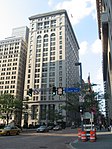Pittsburgh City-County Building
City and town halls in PennsylvaniaCity of Pittsburgh historic designationsCounty government buildings in PennsylvaniaDowntown PittsburghGovernment buildings completed in 1917 ... and 5 more
Government of PittsburghHenry Hornbostel buildingsOffice buildings in PittsburghPittsburgh History & Landmarks Foundation Historic LandmarksTourist attractions in Pittsburgh

The Pittsburgh City-County Building is the seat of government for the City of Pittsburgh, and houses both Pittsburgh and Allegheny County offices. It is located in Downtown Pittsburgh at 414 Grant Street, Pittsburgh, Pennsylvania. Built from 1915-17 it is the third seat of government of Pittsburgh. Today the building is occupied mostly by Pittsburgh offices with Allegheny County located in adjacent county facilities. It also contains a courtroom used for the Pittsburgh sessions of the Supreme Court of Pennsylvania.
Excerpt from the Wikipedia article Pittsburgh City-County Building (License: CC BY-SA 3.0, Authors, Images).Pittsburgh City-County Building
Grant Street, Pittsburgh
Geographical coordinates (GPS) Address Website External links Nearby Places Show on map
Geographical coordinates (GPS)
| Latitude | Longitude |
|---|---|
| N 40.438366666667 ° | E -79.997147222222 ° |
Address
Pittsburgh City-County Building
Grant Street 414
15219 Pittsburgh
Pennsylvania, United States
Open on Google Maps










